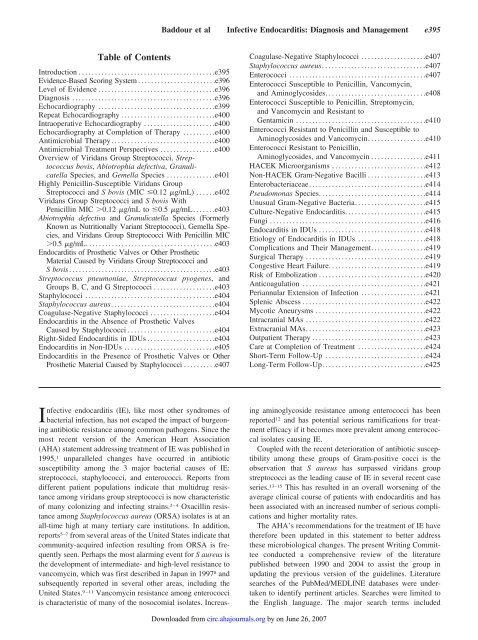Infective Endocarditis Diagnosis, Antimicrobial Therapy, and ...
Infective Endocarditis Diagnosis, Antimicrobial Therapy, and ...
Infective Endocarditis Diagnosis, Antimicrobial Therapy, and ...
You also want an ePaper? Increase the reach of your titles
YUMPU automatically turns print PDFs into web optimized ePapers that Google loves.
Baddour et al <strong>Infective</strong> <strong>Endocarditis</strong>: <strong>Diagnosis</strong> <strong>and</strong> Management e395Table of ContentsIntroduction ..........................................e395Evidence-Based Scoring System ........................e396Level of Evidence ....................................e396<strong>Diagnosis</strong> ............................................e396Echocardiography ....................................e399Repeat Echocardiography .............................e400Intraoperative Echocardiography ......................e400Echocardiography at Completion of <strong>Therapy</strong> ..........e400<strong>Antimicrobial</strong> <strong>Therapy</strong>................................e400<strong>Antimicrobial</strong> Treatment Perspectives .................e400Overview of Viridans Group Streptococci, Streptococcusbovis, Abiotrophia defectiva, GranulicatellaSpecies, <strong>and</strong> Gemella Species ...............e401Highly Penicillin-Susceptible Viridans GroupStreptococci <strong>and</strong> S bovis (MIC 0.12 g/mL) ......e402Viridans Group Streptococci <strong>and</strong> S bovis WithPenicillin MIC 0.12 g/mL to 0.5 g/mL.......e403Abiotrophia defectiva <strong>and</strong> Granulicatella Species (FormerlyKnown as Nutritionally Variant Streptococci), Gemella Species,<strong>and</strong> Viridans Group Streptococci With Penicillin MIC0.5 g/mL........................................e403<strong>Endocarditis</strong> of Prosthetic Valves or Other ProstheticMaterial Caused by Viridans Group Streptococci <strong>and</strong>S bovis .............................................e403Streptococcus pneumoniae, Streptococcus pyogenes, <strong>and</strong>Groups B, C, <strong>and</strong> G Streptococci ...................e403Staphylococci ........................................e404Staphylococcus aureus................................e404Coagulase-Negative Staphylococci ....................e404<strong>Endocarditis</strong> in the Absence of Prosthetic ValvesCaused by Staphylococci ...........................e404Right-Sided <strong>Endocarditis</strong> in IDUs .....................e404<strong>Endocarditis</strong> in Non-IDUs ............................e405<strong>Endocarditis</strong> in the Presence of Prosthetic Valves or OtherProsthetic Material Caused by Staphylococci ..........e407Coagulase-Negative Staphylococci ....................e407Staphylococcus aureus................................e407Enterococci ..........................................e407Enterococci Susceptible to Penicillin, Vancomycin,<strong>and</strong> Aminoglycosides...............................e408Enterococci Susceptible to Penicillin, Streptomycin,<strong>and</strong> Vancomycin <strong>and</strong> Resistant toGentamicin ........................................e410Enterococci Resistant to Penicillin <strong>and</strong> Susceptible toAminoglycosides <strong>and</strong> Vancomycin..................e410Enterococci Resistant to Penicillin,Aminoglycosides, <strong>and</strong> Vancomycin .................e411HACEK Microorganisms .............................e412Non-HACEK Gram-Negative Bacilli ..................e413Enterobacteriaceae....................................e414Pseudomonas Species.................................e414Unusual Gram-Negative Bacteria......................e415Culture-Negative <strong>Endocarditis</strong>.........................e415Fungi ................................................e416<strong>Endocarditis</strong> in IDUs .................................e418Etiology of <strong>Endocarditis</strong> in IDUs .....................e418Complications <strong>and</strong> Their Management.................e419Surgical <strong>Therapy</strong> .....................................e419Congestive Heart Failure..............................e419Risk of Embolization .................................e420Anticoagulation ......................................e421Periannular Extension of Infection ....................e421Splenic Abscess ......................................e422Mycotic Aneurysms ..................................e422Intracranial MAs .....................................e422Extracranial MAs.....................................e423Outpatient <strong>Therapy</strong> ...................................e423Care at Completion of Treatment .....................e424Short-Term Follow-Up ...............................e424Long-Term Follow-Up................................e425<strong>Infective</strong> endocarditis (IE), like most other syndromes ofbacterial infection, has not escaped the impact of burgeoningantibiotic resistance among common pathogens. Since themost recent version of the American Heart Association(AHA) statement addressing treatment of IE was published in1995, 1 unparalleled changes have occurred in antibioticsusceptibility among the 3 major bacterial causes of IE:streptococci, staphylococci, <strong>and</strong> enterococci. Reports fromdifferent patient populations indicate that multidrug resistanceamong viridans group streptococci is now characteristicof many colonizing <strong>and</strong> infecting strains. 2–4 Oxacillin resistanceamong Staphylococcus aureus (ORSA) isolates is at anall-time high at many tertiary care institutions. In addition,reports 5–7 from several areas of the United States indicate thatcommunity-acquired infection resulting from ORSA is frequentlyseen. Perhaps the most alarming event for S aureus isthe development of intermediate- <strong>and</strong> high-level resistance tovancomycin, which was first described in Japan in 1997 8 <strong>and</strong>subsequently reported in several other areas, including theUnited States. 9–11 Vancomycin resistance among enterococciis characteristic of many of the nosocomial isolates. Increasingaminoglycoside resistance among enterococci has beenreported 12 <strong>and</strong> has potential serious ramifications for treatmentefficacy if it becomes more prevalent among enterococcalisolates causing IE.Coupled with the recent deterioration of antibiotic susceptibilityamong these groups of Gram-positive cocci is theobservation that S aureus has surpassed viridans groupstreptococci as the leading cause of IE in several recent caseseries. 13–15 This has resulted in an overall worsening of theaverage clinical course of patients with endocarditis <strong>and</strong> hasbeen associated with an increased number of serious complications<strong>and</strong> higher mortality rates.The AHA’s recommendations for the treatment of IE havetherefore been updated in this statement to better addressthese microbiological changes. The present Writing Committeeconducted a comprehensive review of the literaturepublished between 1990 <strong>and</strong> 2004 to assist the group inupdating the previous version of the guidelines. Literaturesearches of the PubMed/MEDLINE databases were undertakento identify pertinent articles. Searches were limited tothe English language. The major search terms includedDownloaded from circ.ahajournals.org by on June 26, 2007
















